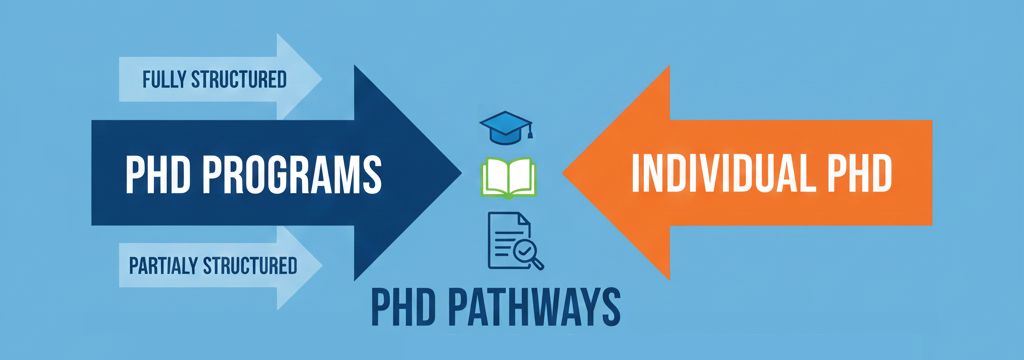
Understanding the different types of PhD pathways is crucial for anyone planning their future academic journey. Broadly, PhDs fall into two main categories: structured PhD programs and individual PhDs (also known as PhD research projects). Structured programs can be further divided into two subtypes: fully structured formats and partially structured formats (also referred to as semi-structured programs). Regardless of the pathway, both structured and individual PhDs involve completing an independent research project, which finishes with writing a dissertation and defending it in a formal viva. This article provides a comprehensive explanation of the key differences between structured PhD programs and individual PhDs.
Differences Between PhD Programs and Individual PhDs
Each type of PhD position has its own unique characteristics, alongside the overlapping specifications they have in common. The following distinct criteria set the structured PhD programs apart from individual PhD research project positions:
- Universities’ schools and departments (or their associated graduate offices), universities’ graduate schools, and non-university research institutes’ research schools manage the application process and oversee the progress of the structured PhD programs. However, as the primary university correspondence, PhD supervisors manage the application process and oversee individual PhD positions.
- While the schools and departments (actually their admission committees) select multiple candidates from a pool of usually hundreds of applicants for structured PhD programs, a research supervisor chooses only one candidate for an individual PhD position from a pool of usually tens of applicants. Thus, the number of students who apply for structured programs is way higher than those applying for research project positions.
- Those accepted to program-based positions might choose their research topic within their first or second year, depending on the country. In France, all applicants to structured PhDs should define their research thesis topic with the help of a supervisor before submitting an application. However, in Australia and the UK, only some applicants to structured programs might know their exact thesis topic before starting their studies. On the other hand, individual PhDs always have predefined titles, enabling the students to choose their research topic as they wish.
- Those who are accepted into program-based positions usually work on an interdisciplinary research project under the supervision of multiple academic supervisors. On the contrary, a student collaborates closely with a single supervisor on a particular research topic in an individual PhD position.
- Structured PhD programs typically feature a defined curriculum with mandatory coursework, exams at the end of each semester, seminars, and workshops. Students in structured PhD programs usually complete coursework in the first 1–2 years, covering research methodologies and subject-specific knowledge. In short, the structured PhD adds a layer of taught modules in relevant disciplinary and specialist areas.
Structured PhD Programs
Fully Structured PhD Programs (North America)
If a PhD position meets all the criteria associated with structured programs mentioned above, it is considered a fully structured PhD. This model is most common in North America, with virtually all Ph.D. programs in the United States and Canada falling under this format. These programs usually take 4 to 6 years full-time (6 to 8 years part-time) and combine coursework, comprehensive exams, seminars, workshops, and original research. Students follow a defined curriculum in the early years, before advancing into research and dissertation writing. As long as applicants enter with a master’s degree, this model is referred to as the regular PhD pathway.

Direct PhD Programs Without Master’s Degree
These incorporate the master’s degree into a longer, usually five- to six-year doctoral program. There are numerous regional names for this format, including fast-track PhD in Germany, direct PhD in USA, integrated PhD in the UK and Australia, direct-entry PhD in Canada, and PhD tracks in France. In STEM fields, where students start advanced coursework and research shortly after earning their bachelor’s degree, these programs are especially prevalent. Through this pathway, highly qualified candidates can continue to receive extensive training and supervision while accelerating their academic journey.
Semi-Structured PhD Programs (Australia, France, Germany, UK)
If one of the core conditions mentioned above for a structured PhD program is only partially met, the program is categorized as a semi-structured format. Let’s have a look at two different scenarios: (i) If the condition #5 is partially met (imagine no final exams), like a PhD in the UK, France, or Germany, it is referred to as a semi-structured PhD program. (ii) If condition #5 is completely irrelevant and the other four conditions are met, like a PhD in Australia, it is referred to as a PhD research program (i.e., a subcategory of semi-structured Ph.D. programs that are less focused on training workshops and seminars compared to other countries).
Joint or Dual PhD Format
Joint PhD programs are a type of semi-structured programs and are common in European countries like the Netherlands and France. They involve collaboration between a host university and a partner university (usually an international institution), allowing students to earn a dual degree issued and awarded jointly by both parties. Students enroll at a host university and a partner university, with a joint PhD agreement outlining supervision and requirements. Such a dual position is supervised by at least two main supervisors, one in each of the two institutions. It typically involves one dissertation, defended at one of the institutions, with examiners from both sides. These joint programs enhance the international scope, ideal for those seeking early global networking.

Individual PhDs (PhD Research Projects)
Individual PhDs are typically found at European universities and research institutes. The ratio of individual to structured format varies from one country to another (for example, individual PhDs contribute to 75% of PhDs in Germany, while the structured format is dominant in France). In this format, students usually work with a single main supervisor. There are no required coursework requirements for this kind of PhD, which gives you more freedom to select your schedule. They are typically funded by a research grant won by supervisors and group leaders in academia and research institutes. You should apply for a PhD research project position with a supervisor whose experience matches your research interests for an enhanced admission chance.
This model is perfect for self-driven independent researchers who value independence and merely want to focus on their dissertation. Depending on the country, field of study, and rate of the student’s research advancement, a full-time funded individual PhD could last 3 to 4 years. The majority of fields, including chemistry, physics, biology, engineering, the humanities, social sciences, and many more, use this model. Deep specialization is made possible by an individual PhD position, where students customize their studies to address particular research questions.
Conclusion
Choosing the right PhD pathway is a pivotal decision that shapes your academic and professional future. You can choose the model that best suits your duration preference, learning style, research objectives, and desired degree of independence by being aware of the differences between structured PhD programs and individual PhDs. While individual PhDs offer flexibility, autonomy, and concentrated collaboration with a single supervisor, structured pathways offer clear coursework, multiple supervisors, and defined training. In the end, both approaches result in original research and a dissertation defense. Prospective candidates can make well-informed decisions and pursue a doctoral journey that best supports their long-term goals by carefully weighing each option.

Frequently Asked Questions (FAQs)
What is the main difference between structured and individual PhDs?
Structured programs include coursework, training, and multiple supervisors, while individual PhDs focus on independent research with minimal coursework and one main supervisor.
Which PhD format is easier to get into?
Neither is universally easier. Structured programs receive more applications, while individual PhDs require a strong match with a supervisor’s research project.
Do all PhDs require coursework?
No. Structured programs typically include coursework; individual PhDs usually do not.
How long does a PhD usually take?
Depending on the country and model, most PhDs take 3–6 years full-time.
Can I choose my research topic in both formats?
In structured programs, you may choose the topic later. Individual PhDs almost always have predefined project titles.
Can I get a PhD without a master’s degree?
Yes, in many countries. Programs such as direct-entry, integrated, or fast-track PhDs combine master’s-level coursework with doctoral research, typically lasting 5–6 years full-time.



Leave Your Comment